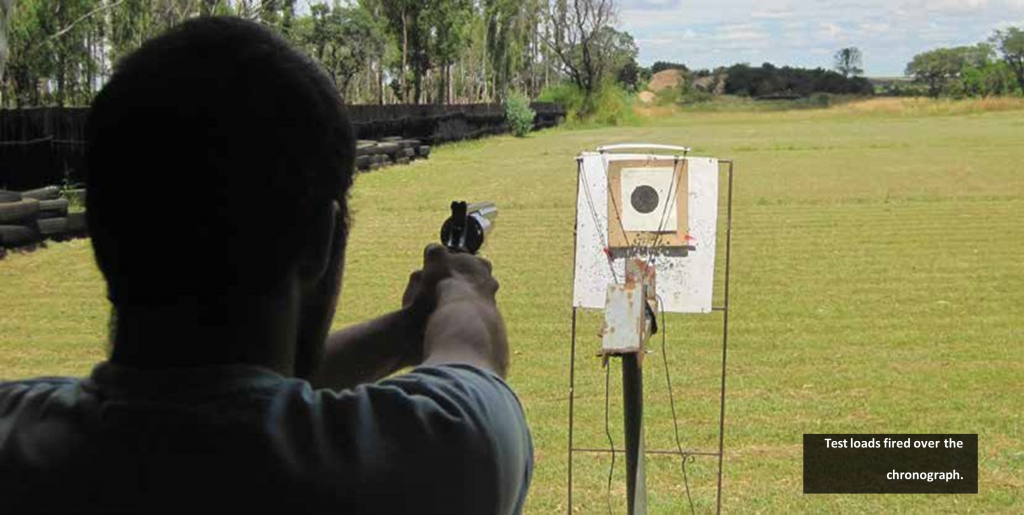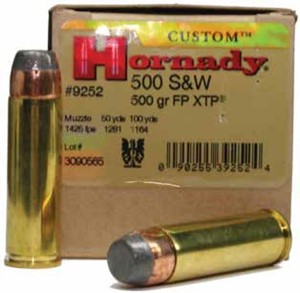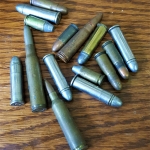
I J LARIVERS
In the hunting world, the handgun will always be a “grey area”. It can be a primary hunting tool, or it can be a backup for professional hunters or guides. In Africa, in the case of canoe guides, it is often the only armament they carry. But will it ever break out of the “bastard son” mould, either in perception or performance? Maybe it finally has. Some years ago, I wrote an article that focused on handguns that attempted to bridge the gap − handguns that came close to providing rifle ballistics. They were the Thompson-Center Contender in .30-30, and the MOA chambered for .358 Winchester.
They were both single shot, and while either would have been suitable for medium-sized game in the same way that Ross Seyfried’s famous single-shot .600 Nitro was, they would have had no value as backup firearms; their main raison d’etre was long-range metallic silhouette work. Later, I wrote about backup guns for PHs, along the lines of the .44 Rem Mag, the newer .480 Ruger, and basically whatever was locally available that could be played with and photographed. At that time, there wasn’t an example of the .500 Smith & Wesson Magnum available in Zimbabwe. Now there is.

It’s been a long time since Dirty Harry’s venerable Smith & Wesson Model 29 was “the most powerful handgun in the world” (the .454 Casull was in existence back then, but didn’t go into commercial production until almost the end of the millennium).
After having blown up a couple of .45 Colts, the legendary Elmer Keith (among other pioneering hand-loaders) settled on the .44 Special cartridge as the building block for his new .44 Magnum, and Smith & Wesson built its first M29 on 15 December 1955 in collaboration with Remington Arms − the .44 Rem Mag pretty much ruled the roost for a good many years, though the odd wildcat came and went.
But early in the 21st Century, Smith & Wesson’s product manager Herb Belin again set out to claim the crown for the world’s most powerful produc-tion handgun. Working in collaboration with Peter Pi of Cor-Bon ammunition, which had built its name around high-performance ammo, the result was a semi-rimmed, straight-walled case which held a .500″ bullet. All well thought-out goals. A semi-rimmed cartridge would headspace on the rim in the revolvers, for which it was primarily designed. But it would also work more reliably in rifle magazines, particularly tubular magazines, than a fully rimmed case. And in terms of the United States’ National Firearms Act, any bullet exceeding .500 in diameter would be classified as a “destructive device” (I thought that was the idea, but anyway…). Linebaugh’s .500 and the .50 Action Express by Whildin, both at .510 both had to be re-designed because of this.

The troubles with wildcats are legion, but if you can get a commercial arms manufacturer to produce the firearm and the ammunition, you’re on your way. In the case of the .500 S&W Mag, the cartridge was brought out by Cor-Bon, together with the Smith & Wesson X-frame revolver at the SHOT Show in 2003 – a new concept for a new millennium. This new combination didn’t come out with Africa in mind, but rather to provide a primary hunting handgun for all things North American.
When Dr Frankenstein made his monster, it probably didn’t wear size 7 shoes. The .500 S&W Magnum is designed around a maximum working pressure of 60,000psi but imagine using a conventional revolver extractor to remove five spent cases at once. Most .500 factory ammunition rates are loaded to some 20% less for this purpose. Proof-testing is done at 20% over pressure, and Smith & Wesson has made this monster of a revolver to withstand 50% over-pressure loads. Also, sadly, cast lead bullets are not recommended as, unlike most .50 calibres where the bore’s groove diameter is the same as the bullet diameter, the Smith & Wesson’s is slightly less at .4983. Leading will occur in the barrel and on the forcing cone, and pressures can become excessive.

The .500 S&W cartridge leaves its primogenitor, the .44 Rem Mag, behind in two very impressive para- meters. The first is bullet weight. For the purpose of this article we were able to play with Hornady XTP hollow points weighing 350gr, and Woodleigh’s jacketed soft-nose tipping the scales at 400gr. The second is velocity. While Elmer Keith envisaged 1,400fps as a sort of benchmark for the .44 with a 240gr bullet, many commercial manufacturers have backed off to around 1 200fps. And, let’s face it, how many folks with a .44 Rem Mag actually put in enough range time to really master it, even at those specs? In the .500, Cor-Bon gives us a 325gr bullet at 1 800fps, a 400gr bullet at 1 625fps and a 440gr load which also zips along at 1 625fps. Some loads are available with 500gr bullets,

Intended for use by a canoe guide on the Zambezi River, this Smith’s long barrel has been shortened to 6″. Despite the foresight not yet having been refitted, accuracy potential was good enough for chronographing. and one high-performance round claims 1 975fps for a 350gr bullet.
Think about that for a minute, rela- tive to a .458 Win Mag perhaps, and then do the maths on the muzzle energy. The Zimbabwe Parks and Wild- life Act mandates muzzle energy of 5.3 kilojoules (kJ) as the power floor for use on heavy dangerous game. Well, this load for the .500 doesn’t quite make it, at 4.1kJ (neither did Karamojo Bell’s 7mm), but this does underscore the cartridge’s potential as a backup gun for African PHs and guides, and it also gives pause for thought to those of us who always recited the old mantra that the most powerful handgun will never equate to any more than a medi- ocre rifle … blah, blah, blah. The .500 S&W has been used on elephant and buffalo, and with heavier bullets with greater sectional densities it can no doubt do the job at appropriate ranges. The .500 is up to 40% more power-
ful than the .460 S&W, which is its only serious challenger, and the possibilities for competent reloaders in both calibres are legion.
Cor-Bon has introduced the .500 Special, as a lower-powered alterna- tive, and there are all sorts of low recoil or reduced recoil offerings on the mar- ket. However, they’re still more of a handful than the .44 Rem Mag. And, to be honest, the calibre is a beast to fire.
S&W offered the revolver with Hogue’s fine Sorbothane grips and a compensa- tor (of which I have always doubted the efficacy for single shots, and I’m not going to double-tap a .500 to see how well it works). As the revolver can weigh five pounds, well, that helps too. The test gun had been scaled back to 6″ for more practical use in the bush, and so the compensator was lost.
We chose Somchem’s S265 as hav- ing an almost ideal burning rate for this application; it is very similar to the American IMR4227 with which I was also familiar. Chris Pakenham, in charge of reloading for Cleveland Pistol Club, was supplied with two bullet types – Hornady’s 350gr JHP in their XTP config- uration, and a very nice Woodleigh 400gr full-jacketed soft-nose. Time was a constraint: we only had one day before the revolver’s owner, a canoe guide, needed to leave for the Zambezi Valley with the gun and ammo.
Eventually, after (careful) trial and error, we chose 41gr of S265 for the 350gr JHP. (We had gone up to 47gr, but the signs of excessive pressure gave us just a little cause for circum- spection.) The results over the chrono- graph were impressive: 1 720fps, which produced muzzle energy of some 2 316 foot pounds, or 3.1kJ.
That is more than “good enough for government work” as the old saying goes, and while we look forward to a lot more experimentation with the calibre in due course, it’s safe to say that the hunting handgun has finally come into its own in a lot of new ways.




Leave a Reply
Want to join the discussion?Feel free to contribute!